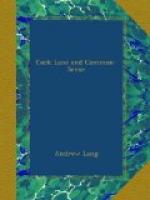On the whole subject Dr. Stewart, of Nether Lochaber, wrote several articles in the Inverness Courier, during the autumn of 1893. The Highland clergy have, doubtless, some difficulty in dealing with the belief among their parishioners. But, as the possession of the accomplishment is no longer regarded as criminal, and as the old theories of diabolical possession, or fairy inspiration, are not entertained, at least by the educated, the seers are probably to be regarded as merely harmless visionaries. At most we may say, with the poet:—
Lo, the sublime telepathist is here.
The belief in witchcraft is also as lively in the Highlands, as in Devonshire, but, while the law takes no cognisance of it, no great harm is done. The witchcraft mainly relies on ‘sympathetic magic,’ on perforating a clay image of an enemy with needles and so forth. There is a very recent specimen in the Pitt Rivers collection, at the museum in Oxford. It was presented, in a scientific spirit, by the victim, who was ‘not a penny the worse,’ unlike Sir George Maxwell of Pollok, two centuries ago.
Though second sight is so firmly rooted in Celtic opinion, the tourist or angler who ‘has no Gaelic’ is not likely to hear much of it. But, when trout refuse to rise, and time hangs heavy in a boat on a loch, it is a good plan to tell the boatman some ghostly Sassenach tales. Then, perhaps, he will cap them from his own store, but point-blank questions from an inquiring southron are of very little use. Nobody likes to be cross-examined on such matters. Unluckily the evidence, for facts not for folklore, is worthless till it has stood the severest cross-examination.
GHOSTS BEFORE THE LAW
Sir Walter Scott on rarity of ghostly evidence. His pamphlet for the Bannatyne Club. His other examples. Case of Mirabel. The spectre, the treasure, the deposit repudiated. Trials of Auguier and Mirabel. The case of Clenche’s murder. The murder of Sergeant Davies. Acquittal of the prisoners. An example from Aubrey. The murder of Anne Walker. The case of Mr. Booty. An example from Maryland, the story of Briggs and Harris. The Valogne phantasm. Trials in the matter of haunted houses. Cases from Le Loyer. Modern instances of haunted houses before the law. Unsatisfactory results of legal investigations.
‘What I do not know is not knowledge,’ Sir Walter Scott might have said, with regard to bogles and bar-ghaists. His collection at Abbotsford of such works as the Ephesian converts burned, is extensive and peculiar, while his memory was rich in tradition and legend. But as his Major Bellenden sings,
Was never wight so starkly made,
But time and years will overthrow.
When Sir Walter in 1831, wrote a brief essay on ghosts before the law, his memory was no longer the extraordinary engine, wax to receive, and marble to retain, that it had been. It is an example of his dauntless energy that, even in 1831, he was not only toiling at novels, and histories, and reviews, to wipe out his debts, but that, as a pure labour of love, he edited, for the Bannatyne Club, ’The trial of Duncan Terig alias Clerk, and Alexander Bane Macdonald, for the murder of Arthur Davis, sergeant in General Guise’s regiment of foot, June, 1754’.




